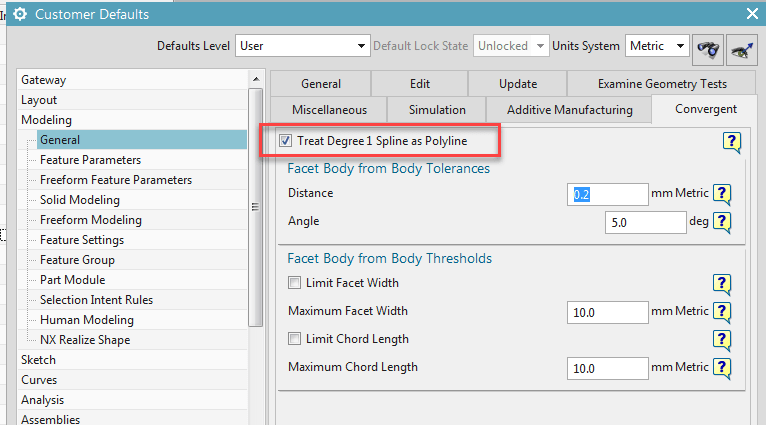@Xwheelguy:
> when I say solid or solid body I am referring to a traditional solid body that's not faceted.
What Convergent Tech (CT) did was add a new surface type to Parasolid. This new surface type is a "mesh", i.e. a collection of triangles joined edge-to-edge. The idea is that this new mesh surface type will be used just the same as any other surface type (like cylinders, spheres, NURBS). So, someday soon, in a solid body (or a sheet body), some of the faces might be mesh surfaces, and some might be "classical" curved surfaces. You won't have to worry about problems arising because some of your surfaces are of "mesh" type, just as you don't have to worry currently if some of your surfaces are NURBS.
> there aren't edges in the same sense that the solid has
Yes there are. Suppose you take two overlapping spheres, convert them both to convergent bodies, and then unite them. You'll get an edge where the two bodies intersect. It won't be circular, though, it will be a "polyline".
> I hope we can also agree they are completely different body types ...
Sorry, but I can't agree. See above.
> Q: Is a convergent model a math model (meaning a traditional solid body)
My answer (regardless of what GTAC told you): The term "convergent model" doesn't really make sense. One possible meaning (I suppose) is that a convergent body is one in which some (or all) of the faces are "mesh" surfaces. But in the near future, that will no longer be a useful distinction: it won't matter that some faces are meshes.
> Q: How would a Boolean operation work between a math model and a faceted model using
> convergent modeling? Would the math model be converted to convergent or both models
> converted to convergent or neither?
> A: It is also my understanding that when a Boolean involves a convergent body that
> the results will remain convergent.
That's true in NX12, but it's temporary. In the near future, mesh surfaces will behave just like any other. So, when you do a boolean, the faces of the resulting object will be derived directly from the faces of the tool and target. So, if the tool or target has some mesh faces, the result will have some, too.
> I trust that this person is accurate and isn't misleading.
I'd say the answers are accurate (relative to NX12), but they're misleading because they cause people to think in a way that's inconsistent with the direction of the technology.
> Reading the Q&A above, it sounds to me like a convergent model is still a faceted model
> and there isn't any mixing between solids and facets at all (at least on a solid).
Not yet. In NX12, in a given body, either all the faces have to be classical curvy ones, or they all have to be meshes. There is no mixing in NX12.
> For example, if you put a hole in a convergent model, you won't be able to use a diametral
> or cylindrical dimension on the faceted model because there are no faces or edges that are cylindrical
True today, but not for long. However, it's important to note that the edge of the hole will still be a polyline, which won't be any good for dimensioning. So, the dimension will need to be attached to the cylindrical surface, not the edge(which is the right of doing it, anyway, in my opinion).
> Still interweb buds, I hope.
Sure.
The Siemens vision (as opposed to today's reality) is described in this post:
or the first dozen slides in this presentation:


![[wink] [wink] [wink]](/data/assets/smilies/wink.gif)